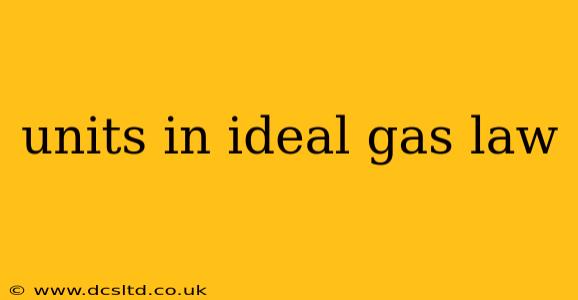The Ideal Gas Law, PV = nRT, is a cornerstone of chemistry and physics, describing the behavior of ideal gases. Understanding the units involved is crucial for accurate calculations and a deep comprehension of the law itself. This guide will delve into the units of each variable, explore common unit conversions, and address frequently asked questions surrounding unit compatibility.
What are the units of each variable in the Ideal Gas Law?
Let's break down the units for each component of PV = nRT:
-
P (Pressure): Pressure is typically measured in atmospheres (atm), Pascals (Pa), kilopascals (kPa), millimeters of mercury (mmHg), or torr. The choice depends on the context and the units of other variables in the equation.
-
V (Volume): Volume is usually expressed in liters (L) or cubic meters (m³). Again, consistency with other units is key.
-
n (Number of moles): This represents the amount of substance and is always measured in moles (mol).
-
R (Ideal gas constant): The value of R depends on the units used for pressure and volume. This is a crucial point! The most common values are:
- 0.0821 L·atm/mol·K (when pressure is in atm and volume is in L)
- 8.314 J/mol·K (when pressure is in Pa and volume is in m³)
- 62.36 L·mmHg/mol·K (when pressure is in mmHg and volume is in L)
-
T (Temperature): Temperature must always be in Kelvin (K). Never use Celsius or Fahrenheit directly in the Ideal Gas Law. Remember to convert Celsius to Kelvin using the formula: K = °C + 273.15.
What happens if I use inconsistent units?
Using inconsistent units will lead to an incorrect answer. The Ideal Gas Law is dimensionally consistent; the units on both sides of the equation must match. If your units don't align with the value of R you've chosen, your calculated result will be wrong. Always double-check your units before and after calculations.
How do I convert between different pressure units?
Converting between pressure units is frequently necessary. Here are some common conversions:
- atm to Pa: 1 atm = 101325 Pa
- atm to mmHg: 1 atm = 760 mmHg
- atm to kPa: 1 atm = 101.325 kPa
- mmHg to Pa: 1 mmHg = 133.322 Pa
How do I convert between different volume units?
Volume conversions are also common:
- L to m³: 1 L = 0.001 m³
- m³ to cm³: 1 m³ = 1 x 10⁶ cm³
What if I'm given the mass instead of moles?
If you're given the mass (in grams) of a gas, you need to convert it to moles using the molar mass (M) of the gas:
n = mass (g) / M (g/mol)
The molar mass is found on the periodic table for individual elements or calculated from the chemical formula for compounds.
Why is the temperature always in Kelvin?
The Kelvin scale is an absolute temperature scale, meaning zero Kelvin represents absolute zero—the lowest possible temperature. Using Kelvin ensures that temperature is always positive and directly proportional to the average kinetic energy of the gas particles. Celsius and Fahrenheit, being relative scales, would lead to inconsistencies and incorrect calculations in the Ideal Gas Law.
Are there any limitations to the Ideal Gas Law?
The Ideal Gas Law is a simplification; real gases deviate from ideal behavior under certain conditions, particularly at high pressures and low temperatures. At these conditions, the intermolecular forces and the finite volume of the gas molecules become significant, and more complex equations of state are needed.
By understanding the units and their interrelationships within the Ideal Gas Law, you can confidently perform calculations and gain a deeper understanding of gas behavior. Remember consistency is key—choose your units carefully and stick with them throughout your calculations.
